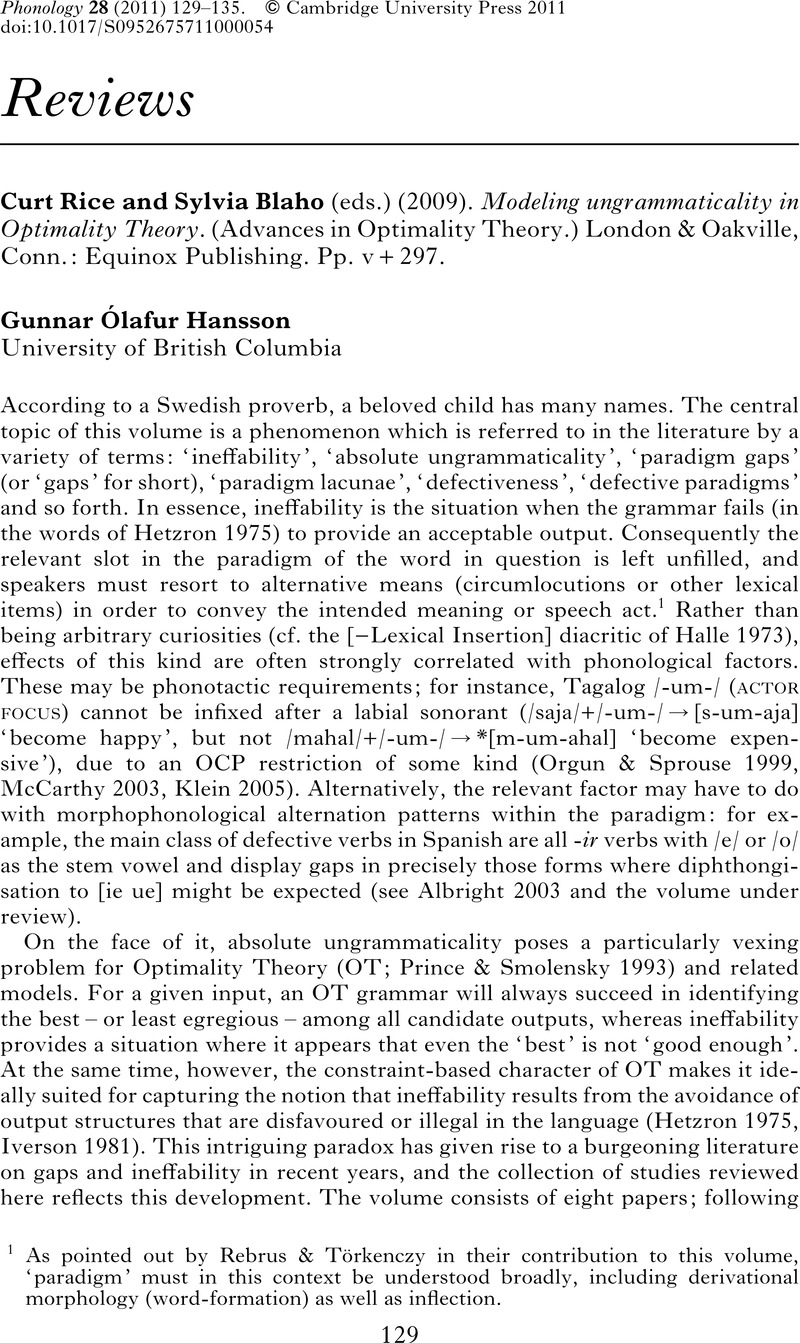No CrossRef data available.
Article contents
Curt Rice and Sylvia Blaho (eds.) (2009). Modeling ungrammaticality in Optimality Theory. (Advances in Optimality Theory.) London & Oakville, Conn.: Equinox Publishing. Pp. v+297.
Review products
Curt Rice and Sylvia Blaho (eds.) (2009). Modeling ungrammaticality in Optimality Theory. (Advances in Optimality Theory.) London & Oakville, Conn.: Equinox Publishing. Pp. v+297.
Published online by Cambridge University Press: 15 April 2011
Abstract
An abstract is not available for this content so a preview has been provided. Please use the Get access link above for information on how to access this content.

Information
- Type
- Book Review
- Information
- Copyright
- Copyright © Cambridge University Press 2011
References
REFERENCES
Ackema, Peter & Neeleman, Ad (2000). Absolute ungrammaticality. In Dekkers, Joost, Leeuw, Frank van der & de Weijer, Jeroen van (eds.) Optimality Theory: phonology, syntax, and acquisition. Oxford: Oxford University Press. 279–301.CrossRefGoogle Scholar
Alderete, John D. (2001). Dominance effects as transderivational anti-faithfulness. Phonology 18. 201–253.CrossRefGoogle Scholar
Anttila, Arto (2002). Variation and phonological theory. In Chambers, J. K., Trudgill, Peter & Schilling-Estes, Natalie (eds.) The handbook of language variation and change. Oxford: Blackwell. 206–243.Google Scholar
Baerman, Matthew (2008). Historical observations on defectiveness: the first singular non-past. Russian Linguistics 32. 81–97.CrossRefGoogle Scholar
Hansson, Gunnar Ólafur (1999). ‘When in doubt …’: intraparadigmatic dependencies and gaps in Icelandic. NELS 29:1. 105–119.Google Scholar
Iverson, Gregory K. (1981). Rules, constraints, and paradigm lacunae. Glossa 15. 136–144.Google Scholar
Klein, Thomas B. (2005). Infixation and segmental constraint effects: UM and IN in Tagalog, Chamorro, and Toba Batak. Lingua 115. 959–995.CrossRefGoogle Scholar
Kulinich, Elena (2010). Les nouveaux verbes défectifs du russe. Paper presented at the Annual Meeting of the Canadian Linguistic Association, Montréal.Google Scholar
McCarthy, John J. (2003). OT constraints are categorical. Phonology 20. 75–138.CrossRefGoogle Scholar
Oostendorp, Marc van (2007). Derived environment effects and consistency of exponence. In Blaho, Sylvia, Bye, Patrik & Krämer, Martin (eds.) Freedom of analysis? Berlin & New York: Mouton de Gruyter. 123–148.CrossRefGoogle Scholar
Orgun, Cemil Orhan & Sprouse, Ronald L. (1999). From MParse to Control: deriving ungrammaticality. Phonology 16. 191–224.CrossRefGoogle Scholar
Pertsova, Katya (2005). How lexical conservatism can lead to paradigm gaps. UCLA Working Papers in Linguistics 11: Papers in Phonology 6. 13–38.Google Scholar
Prince, Alan & Smolensky, Paul (1993). Optimality Theory: constraint interaction in generative grammar. Ms, Rutgers University & University of Colorado, Boulder. Published 2004, Malden, Mass. & Oxford: Blackwell.Google Scholar
Raffelsiefen, Renate (1992). A nonconfigurational approach to morphology. In Aronoff, Mark (ed.) Morphology now. Albany: State University of New York Press. 133–162.Google Scholar
Raffelsiefen, Renate (2004). Absolute ill-formedness and other morphophonological effects. Phonology 21. 91–142.CrossRefGoogle Scholar
Rice, Curt (2005). Optimal gaps in optimal paradigms. Catalan Journal of Linguistics 4. 155–170.CrossRefGoogle Scholar
Rice, Curt (2007). Gaps and repairs at the phonology–morphology interface. JL 43. 197–221.CrossRefGoogle Scholar
Sims, Andrea D. (2006). Minding the gaps: inflectional defectiveness in a paradigmatic theory. PhD dissertation, Ohio State University.Google Scholar
Szakay, Anita & Hansson, Gunnar Ólafur (2010). A probabilistic approach to Hungarian paradigm gaps. Poster presented at the 14th International Morphology Meeting, Budapest.Google Scholar
Weijer, Jeroen van de (2002). An Optimality Theoretic analysis of the Dutch diminutive. In Broekhuis, Hans & Fikkert, Paula (eds.) Linguistics in the Netherlands 2002. Amsterdam & Philadelphia: Benjamins. 199–209.Google Scholar

